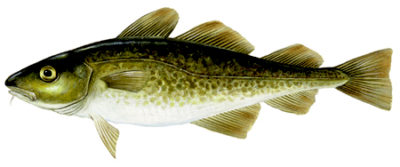
Other Species in the NIFCA District
Atlantic cod (Gadus morhua)
A bottom-feeding fish with a pronounced chin barbell that is used to find prey. They can often be found by sea anglers in the autumn and winter months when cod returns to the UK from colder waters although some remain in the UK all year round.
Atlantic mackerel (Scomber scombrus)
A migratory fast-swimming fish that is an important food source for marine predators including bottlenose dolphins. Recreational angling for mackerel is popular in the district when they migrate inshore to feed on small fish and zooplankton during the summer months.
Common periwinkle (Littorina littorea)
A small gastropod mollusc found on most rocky shores around the UK. Identified by a dark brown banded shell and white base. These molluscs feed by grazing algae from the rocks using a rasping tongue called a radula!
Edible mussel (Mytilus edulis)
The bivalve mollusc are filter feeders that can form dense beds by producing sticky tough threads called byssus threads. Annual surveys are completed on mussel beds in the Blyth estuary and at Lindisfarne National Nature Reserve to record mussel bed population dynamics.
Grey seal (Halichoerus grypus)
The largest of two UK seal species, grey seals can be distinguished by a longer snout than the common or harbour seal. Within the NIFCA district we have internationally important populations within the Berwickshire & North Northumberland SAC with sightings all year round.
Bottlenose dolphin (Tursiops truncatus)
Grey in colour, with a darker grey near their dorsal fin and paler underside, these mammals use echolocation to navigate and predate prey! A fast-moving gregarious marine mammal that is often seen from shore and sea all year round in the district.
Sea lamprey (Petromyzon marinus)
A nationally rare migratory fish that can be found in the Tweed Estuary SAC, where it moves back into sandy gravel freshwater to spawn. The jawless adults have an eel like appearance with a mouth full of teeth that feeds parasitically on other fish!
Common brittlestar (Ophiothrix fragilis)
A large species of brittlestar with a disc-like body and 5 long spiny arms. The arms are fragile and detach from the body if they are disturbed or feel threatened! The species gather in large numbers near the Farne Islands creating dense brittlestar beds.
Birds
The northeast coast of England is home to a wide range of seabird species, including breeding or over-wintering species which can only be seen at certain times of the year. Lindisfarne National Nature Reserve, the Farne Islands, and Coquet Island all support nationally important numbers of seabirds. Please see below for an example of some of the species that can be found in the region.
Common eider (Somateria mollissima)
Locally known as cuddy ducks, approximately a third of the English eider population is found in Northumberland which is why the Berwick to St Mary’s Marine Conservation Zone was established. The large true sea duck feeds on coastal molluscs with mussels a particular favourite.
Puffin (Fratercula arctica)
These charismatic birds return in their thousands during breeding season (April – July) to the Inner Farnes and Coquet Island, where they nest in burrows. They feed on fish mostly sand eels with their rough tongue allowing them to grab onto more than one fish at a time!
Roseate tern (Sterna dougallii)
Named after the rosy summer plumage this is one of the rarest birds in the UK with just one regular nesting colony on Coquet Island! Similar in appearance to Arctic terns they are mostly white with a black cap, red legs and black beak with reddish base during the summer.
